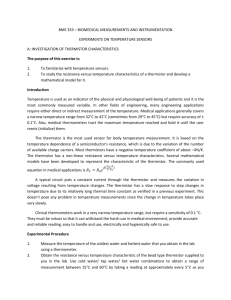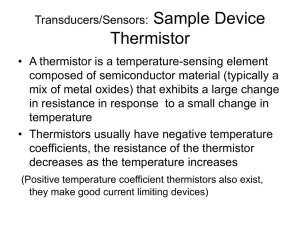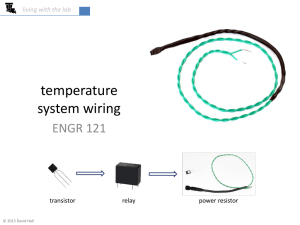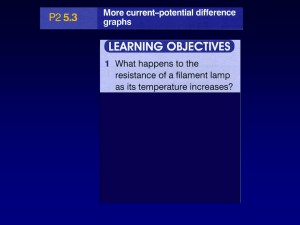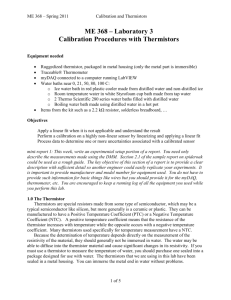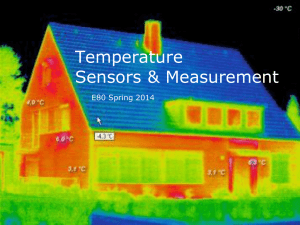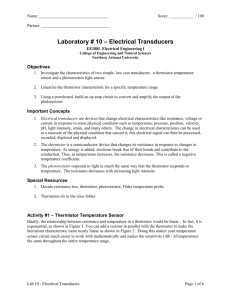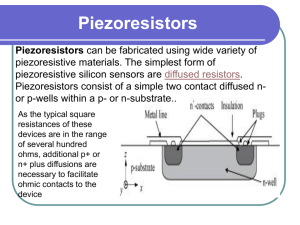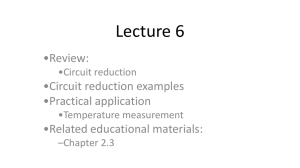Example
advertisement
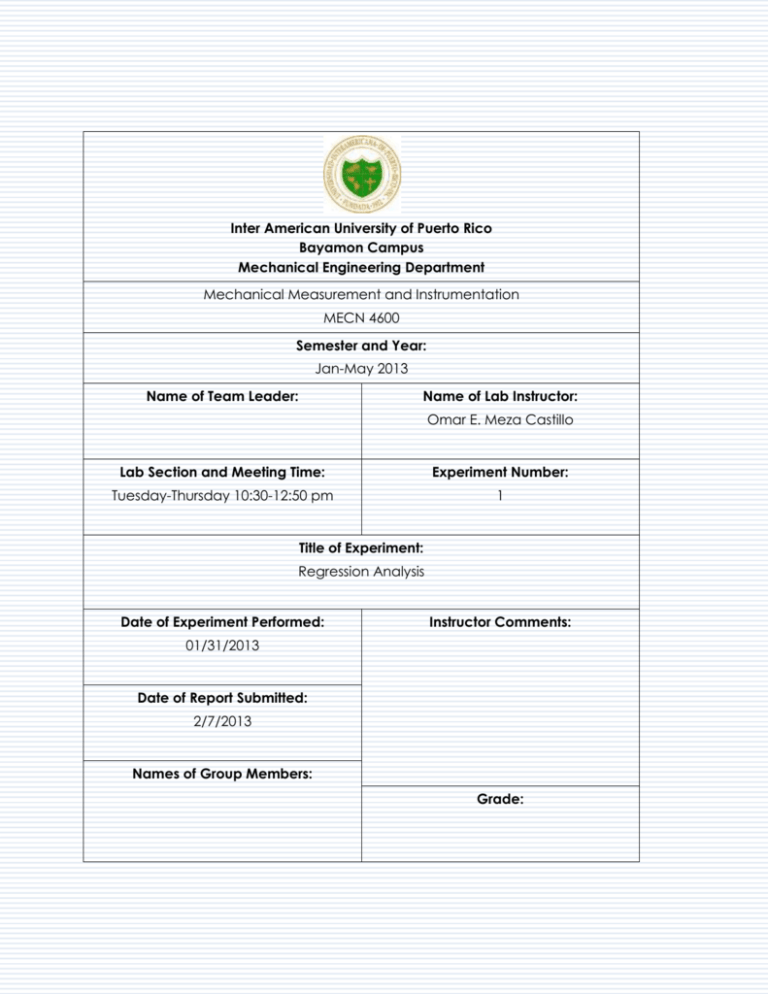
Inter American University of Puerto Rico Bayamon Campus Mechanical Engineering Department Mechanical Measurement and Instrumentation MECN 4600 Semester and Year: Jan-May 2013 Name of Team Leader: Name of Lab Instructor: Omar E. Meza Castillo Lab Section and Meeting Time: Experiment Number: Tuesday-Thursday 10:30-12:50 pm 1 Title of Experiment: Regression Analysis Date of Experiment Performed: Instructor Comments: 01/31/2013 Date of Report Submitted: 2/7/2013 Names of Group Members: Grade: Table of Contents Abstract .............................................................................................................................. 3 Objectives and Introduction ........................................................................................... 4 Equipment Description and Specification .................................................................... 5 Results and discussion .................................................................................................... 11 Conclusions ...................................................................................................................... 13 References ....................................................................................................................... 14 Page | 2 Abstract Since we have only these fixed temperatures to use as a reference, we must use instruments to interpolate between them. But accurately interpolating between these temperatures can require some fairly exotic transducers, many of which are too complicated or expensive to use in a practical situation. We shall limit our discussion to themost common temperature transducers: thermistor. In this laboratory these procedures will come to practice with a thermistor to check the accuracy of the results comparing them with a lead resistance. In this laboratory 10 V were carried to a Wheatstone bridge and the Eout was read. The thermistor along with the Wheatstone bridge was found to be very accurate in the experiment. Tabulated tables explaining the values of the data are included in the conclusion explain the accuracy of the thermistor. The value of β obtained was 4138 K. Page | 3 Objectives To familiarize the student with measurement of temperature using a thermistor. To mount the setup of the laboratory using a Voltage divider circuit. Introduction A thermistor is a type of resistor whose resistance varies significantly with temperature, more so than in standard resistors. The word is a portmanteau of thermal and resistor. Thermistors are widely used as inrush current limiters, temperature sensors, self-resetting overcurrent protectors, and self-regulating heating elements.2 in other words athermistor is a resistor, or type of sensor used to regulate and measure temperature, such as heat and cold. A thermistor is made up of ceramic with a high precision at a specific temperature level. The thermistor contains electrical networks, circuits and wires. The main characteristics of a thermistor are: power, noise, tolerance, temperature and resistance. You can use a thermistor for many different things such as Meter Compensation, Inrush-Current Device, Automotive Applications, Differential Thermometers and Master-Slave Control as well as others. For this lab report we’re going to be using the thermistor for the measurement of temperature with the relation of resistance. Page | 4 Theory The idea of a thermistor, or thermally sensitive resistor, has been around for over 150 years. Although one of his lesser-known discoveries, the first documented use of an NTC, (Negative Temperature Coefficient, something to be returned to in the theoretical basis section), thermistor came from Michael Faraday in 1833. After the initial discovery, it was quickly realized that thermistors could be separated entirely into two different categories: NTC and PTC thermistors. Interestingly, the classification didn’t solely depend on metallurgical properties due to the fact that at certain temperatures some types can actually switch categories. Silicon is one such example that exhibits NTC properties until 250K, where a positive temperature coefficient sets in. All thermistors are made using semi-conducting metallic compound oxides such as manganese, copper, cobalt, and nickel, as well as single-crystal semiconductors silicon and germanium [1]. Many different types of thermistors exist for different uses. The coated lens type is one example. While Faraday was first to discover the thermistor properties of semiconductors, Samuel Ruben was quickest to perfect it and seal it under a U.S. patent. Almost a century after Faraday’s breakthrough, Ruben released his “Electrical Pyrometer Resistance” findings in which housed a special technique to “cook” a copper base in an oxidizing atmosphere to create a cuprous oxide. After being cleansed in hydrochloric and nitric acid, a thin film of this oxide remained that gave his thermistor a negative temperature coefficient without the drawbacks of standard semiconducting materials. He explains in his patent that as he experimented with adding heat to the device, its resistance dropped noticeably and reproducibly. As a final notable mention, Rueben explains similar phenomena occurred when mixing the cuprous oxide with cuprous sulphide, or melting antimony sulphide with cuprous sulphide. The practicality of this intricate thermistor was Page | 5 widespread, as it drove applications in voltage protection, temperature control, and calorimetric to name a few. The notion of resistance increasing with temperature in regular conducting materials, however, is not a new one by any means. A. E. Kennelly and Reginald A. Fessenden write in 1893 in the Physical Review about the linear relationship between increased temperature and resistance in a sample of copper. In their testing between the ranges of -69⁰C and123⁰C, the same range we have worked in, they explain how copper’s temperature coefficient is a positive 4.18% per degree Celsius. It was only a few decades’ later whenphysicists made perhaps the most astonishing discovery relating to electricalconductivity. On April 8, 1911, Kamerlingh Onnes and his cohorts experimented with vapor pressures of liquid helium to drop the temperatureof mercury to a level where resistance “practically” disappeared. Today, we denote this phenomenon as superconductivity and it involves similarquantum effects explored in the theory section of this report on thermistors. Historical experimenting has proven to us that the relationshipbetween resistance and temperature can take wildly different turns given thecircumstances and materials used. Some Formulas Used For the experiment: The calibration equation for an Thermistor is given by an expression of the following form: R exp R0 1 1 T T0 …………………….. (1) Page | 6 Setting the experiment: Figure 1: Thermocuple Setting Page | 7 Experimental Methods We began this experiment by acquiring ice and mixing it with tap water. The instruments necessary for the procedures were conveniently laid out beforehand, and thus we were able to begin immediately. Before connecting the canister to the wall outlet, we brought the metal inside down to roughly 0⁰C by flushing it with ice-cold water from the large beaker. Another pre-experiment task was to determine the lead resistance on the wires we had for use. This was determined by inserting them into the multi-meter, ensuring the multi-meter was on and reading resistance on a Ω scale, and rubbing the leads together to remove a bit of corrosion. Once satisfied, we left the water inside the canister, plugged in the resistance heater, and opted to begin with the copper coil apparatus. We placed it snugly onto the canister, inserted the thermometer and observed the multi-meter to ensure a proper connection had been made. The temperature was brought up to 10⁰Cfor the first data point, and the data collection was underway. Thus, we were able to observe the linear relationship between Resistance and Temperature on the fly during the copper experiment to ensure all equipment and procedures were optimal. We attempted, and mostly succeeded, in taking data points for every 10⁰C increase in temperature. Therefore, a total of nine data points were taken ending with a 90⁰C data point. Once this portion of the lab had concluded, we removed all the components, turned off/unplugged electronics, and cleaned beakers in order to prepare for the next usage [2]. Page | 8 Equipment description & Specification Figure 2: Thermistor Thermistor is athermally sensitive resistor hence the name (Figure 2). Thermistor is a solid semiconducting material. Unlike metals, thermistors respond inversely to temperature. i.e., their resistance decreases as the temperature increases. The thermistors are usually composed of oxides of manganese, nickel, cobalt, copper and several other nonmetals. Figure 3: hot beaker and water. Page | 9 • Hot plates (Figure 3) are laboratory tools used to uniformly heat samples. Hot plates provide less heat, but do so without the danger associated with the open flame and higher temperatures of a Bunsen burner. Hot plates are available with a number of different heating top styles. The most common types include those constructed from aluminum, ceramic materials or enamel. Aluminum topped hot plates provide a rapid heating surface, which retains and distributes heat very well. Figure 4: Mercury Thermometer • A mercury-in-glass thermometer, also known as a mercury thermometer, was invented by German physicist Daniel Gabriel Fahrenheit in 1714 and is a thermometer consisting of mercury in a glass tube. Calibrated marks on the tube allow the temperature to be read by the length of the mercury within the tube, which varies (nearly linearly) according to the temperature of the mercury. To increase the sensitivity, there is usually a bulb of mercury at the end of the thermometer which contains most of the mercury; expansion and contraction of this volume of mercury is then amplified in the much narrower bore of the tube. The space above the mercury may be filled with nitrogen or it may be less than atmospheric pressure, which is normally known as a vacuum. Page | 10 Figure 5: Multi-Meter • HP-Digital Multi-Meter (HP-DMM) Digital multi-meters or multi-meter, (Figure 5) are instruments that are used to measure electrical quantities such as voltage, current, resistance, frequency, temperature, capacitance, and time period measurements. Basic functionality includes measurement of potential in volts, resistance in ohms, and current in amps. Multi-meters are used to find electronic and electrical problems. Advanced units come with more features such as capacitor, diode and IC testing modes.4 Page | 11 Figure 6: Voltage Divider Circuit • Voltage Divider In electronics, a voltage divider also known as a potential divider (Figure 6) is a linear circuit that produces an output voltage (Vout) that is a fraction of its input voltage (Vin). Voltage division refers to the partitioning of a voltage among the components of the divider. Page | 12 Results and Discussion Data was taking using different temperatures. The data was analyzed and applying the formula given in class the following results were obtained Table 1: Data Of the thermistor T (˚C) V (V) RTH (kΩ) RTH / R0 23 -2.062 6.4419 1 26 -1.78 5.6430 0.876 T0 (˚C) 23 28 30 32 34 36 38 40 42 44 46 -1.4 -1.26 -1.04 -0.838 -0.587 -0.423 -0.219 -0.0235 0.133 0.369 4.7644 4.4858 4.0877 3.7592 3.3930 3.1754 2.9255 2.7053 2.5411 2.3116 0.7396 0.6963 0.6345 0.5836 0.5267 0.4929 0.4541 0.42 0.3945 0.3588 Ein (V) 10 Ein (V) 10 Rw (kΩ) 2.68 R (kΩ) 3.25 Rw (kΩ) 2.68 R0 (kΩ) 6.4419 Eout (V) R (kΩ) -0.496 3.27 Table 2: Data Analyzed T (˚C) 23 26 28 30 32 34 36 38 40 42 44 46 T(K) 296.15 299.15 301.15 303.15 305.15 307.15 309.15 311.15 313.15 315.15 317.15 319.15 (1/T-1/To) 0 -3.4E-05 -5.6E-05 -7.8E-05 -1E-04 -0.00012 -0.00014 -0.00016 -0.00018 -0.0002 -0.00022 -0.00024 RTH / R0 1 0.875987 0.739608 0.696349 0.63455 0.583561 0.526707 0.492927 0.454143 0.419959 0.39447 0.358844 ln() 0 -0.1324 -0.3016 -0.3619 -0.4548 -0.5386 -0.6411 -0.7074 -0.7893 -0.8676 -0.9302 -1.0249 Page | 13 The graph of the data analyzed is presented: Thermistor Analysis -0.0003 -0.00025 -0.0002 -0.00015 -0.0001 y = 4138.4x - 0.029 R² = 0.9951 0 -0.00005 0 -0.2 Rth/Ro -0.4 -0.6 -0.8 -1 Rth/R0 -1.2 Graph 7: Rth/Ro results It represents the slope of the data taken by the thermistor. The results came quite correct due to the precision of the procedures used. Each data points represent a linearity equation of a 0.0029 slope representation. The value of β obtained was 4138 K, this value is close to the manufacturer value. Page | 14 Conclusion After finishing the experiment, we understood the relationship of Resistance and temperature of athermistor. After performing the experiment all the objective were successfully accomplished. A least square analysis was performed of the obtain data to establish a linear equation that will describe the behavior of the thermocouple. The established equations were compared to those calculated by Excel and were close enough. A least square with a 0.989 and a linearity error of 0.02% suggest that the thermistoris very accurate compared with the resistances. The value of β obtained was 4138 K, this value is close to the manufacturer value. Page | 15 References [1] O. Meza “Lecture08: Measurement of Temperature – Thermistor” http://facultad.bayamon.inter.edu/omeza/ [2] Stig Ekelof “Wheatstone bridge” http://en.wikipedia.org/wiki/Wheatstone_bridge” [3] McGee, Thomas (1988). "Chapter 9". Principles and Methods of Temperature Measurement.John Wiley & Sons.p. 203. Page | 16
